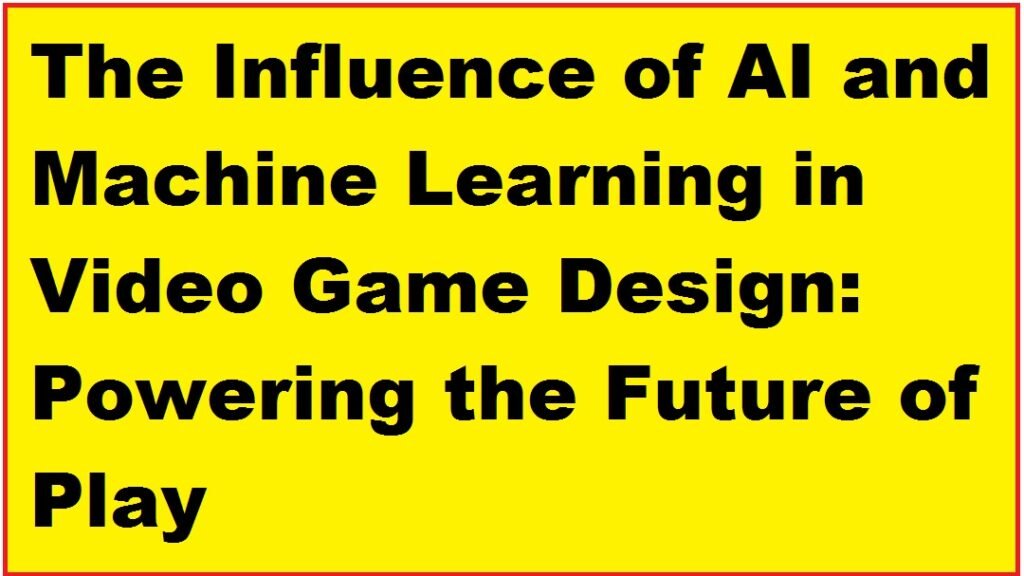The Influence of AI and Machine Learning in Video Game Design: Powering the Future of Play

The world of video games has always been a breeding ground for technological innovation. From the blocky characters of early consoles to the breathtaking visuals of today’s VR experiences, the industry thrives on pushing boundaries and creating ever-more immersive realities. In recent years, Artificial Intelligence (AI) and Machine Learning (ML) have emerged as powerful tools that are revolutionizing the way video games are designed, played, and experienced.
This article delves into the profound impact of AI and ML on video game design. We’ll explore how these technologies are used, the benefits they bring to both players and developers, the challenges that need to be addressed, and the exciting potential they hold for the future of gaming.
Understanding the Fundamentals: AI vs. ML
Before we dive in, let’s establish a clear distinction between AI and ML. Artificial Intelligence refers to a machine’s ability to exhibit human-like intelligence, encompassing tasks like learning, reasoning, problem-solving, and even language comprehension. Machine Learning, on the other hand, is a subfield of AI that focuses on developing algorithms that can learn and improve from experience without explicit programming. In simpler terms, AI defines the what (intelligent behavior), while ML provides the how (algorithms) for achieving that goal.
The AI and ML Toolbox for Game Developers
AI and ML are no longer futuristic concepts in game design; they’re actively shaping the industry. Here are some of the most impactful ways these technologies are being used:
- Procedural Content Generation (PCG): Imagine a game where every playthrough offers unique levels, quests, and environments. AI and ML algorithms make this a reality. They can dynamically generate vast amounts of game content, from intricate maps and diverse landscapes to unique enemy encounters and story elements. This not only enhances replayability but also frees developers to focus on core mechanics and world-building.
- Adaptive Gameplay: Gone are the days of static difficulty settings. AI-powered systems can now analyze player behavior in real-time, including skill level, preferences, and playstyle. Based on this data, the game can dynamically adjust difficulty, pacing, enemy encounters, and even reward structures to create a personalized experience. Players are constantly challenged but never frustrated, leading to a more engaging and satisfying gameplay loop.
- Non-Player Character (NPC) Behavior: AI and ML are breathing life into NPCs. These algorithms can create complex decision-making capabilities for NPCs, allowing them to react realistically to player actions, navigate environments intelligently, and even learn from past interactions. This results in more believable and engaging characters that truly feel like part of the game world.
- Proactive Bug Detection and Fixing: The development process is no longer plagued by the constant hunt for bugs and glitches. AI-driven tools can now analyze gameplay data and identify potential issues before they even reach players. Additionally, ML algorithms can learn from past bugs and suggest fixes or even automate the process entirely, saving valuable development time and resources.
Benefits of AI and ML in Video Game Design
The integration of AI and ML into video game design offers a multitude of benefits for both players and developers:
- Enhanced Player Experience: Dynamic content generation, adaptive gameplay, and lifelike NPC behaviors create a more immersive and personalized gaming experience. Players feel a deeper connection to the game world, leading to increased engagement, satisfaction, and overall enjoyment.
- Efficiency in Development: Automated tools powered by ML algorithms streamline various aspects of game development. Content creation, bug fixing, playtesting, and data analysis become more efficient, allowing developers to focus on the creative aspects of game design and deliver higher-quality experiences in shorter timeframes.
- Data-Driven Insights: AI analytics tools gather and analyze vast amounts of player data, revealing valuable insights into gameplay patterns, preferences, feedback, and engagement metrics. This data empowers developers to make informed decisions regarding game design, updates, monetization strategies, and community management.
Challenges and Considerations
While AI and ML hold immense potential, there are challenges that need to be addressed:
- Ethical and Moral Dilemmas: As AI and ML become more sophisticated, ethical questions arise. These include data privacy concerns, potential biases in algorithms, ensuring fairness in gameplay, and the psychological impact of increasingly immersive experiences. Developers need to tread carefully and prioritize responsible implementation of these technologies.
- Technical Complexity: Implementing advanced AI and ML systems requires expertise in machine learning algorithms, data processing, optimization, and integration with game engines. Developers need to overcome technical hurdles to ensure compatibility, performance, and scalability of these systems within their games.
The Future of AI and ML in Gaming: A Glimpse into the Unseen
- Generative Adversarial Networks (GANs): Imagine a world where game environments are indistinguishable from reality, with characters that move and interact with an unprecedented level of detail. Generative Adversarial Networks (GANs) are a type of AI that hold immense promise in this regard. GANs can pit two neural networks against each other, one generating content (like game graphics) and the other trying to distinguish it from real data. This continuous loop refines the generated content, leading to hyper-realistic visuals, animations, textures, and virtual environments that blur the line between reality and the game world.
- Reinforcement Learning (RL) for Game AI: Imagine enemies that adapt to your tactics, learn from your strategies, and pose a constant intellectual challenge. Reinforcement Learning (RL) algorithms can make this a reality. RL allows AI agents to learn through trial and error, constantly improving their behavior based on interactions with the game environment. This could lead to the creation of intelligent and adaptive AI opponents in both multiplayer and single-player games, making every encounter a unique and challenging test of skill.
- AI-powered Content Creation Tools: Imagine a future where players themselves can influence and even create elements of the game world. AI-powered content creation tools could allow players to design their own levels, characters, or even storylines. These tools could use AI to guide players through the creation process, ensuring content adheres to the game’s core mechanics and aesthetics. This would foster a deeper connection between players and the game world, allowing for unparalleled levels of personalization and community-driven content creation.
- AI-driven Game Narration and Storytelling: The way stories are told in video games could be revolutionized by AI. AI algorithms could analyze player choices, actions, and preferences to dynamically adjust the narrative, creating a truly personalized and interactive story experience. This could lead to branching storylines that adapt to player decisions, or even games that craft unique narratives for each player based on their gameplay style.
- AI for Game Accessibility: The future of gaming is inclusive. AI can play a crucial role in making games more accessible to players with disabilities. For instance, AI-powered tools could generate audio descriptions of game environments for visually impaired players, or create customized control schemes for players with physical limitations. This would ensure that everyone can enjoy the immersive world of video games.
In conclusion, AI and Machine Learning are poised to transform the gaming landscape in ways we can only begin to imagine. From hyper-realistic visuals and intelligent AI opponents to player-driven content creation and personalized storytelling, the future of gaming promises to be a playground of unprecedented creativity and engagement. As developers continue to explore the potential of these technologies, we can expect even more groundbreaking advancements that will redefine the way we experience and interact with video games.
- Innovative Game Design Techniques: Elevating User Experience to New Heights
 Innovative Game Design Techniques: In the ever-evolving realm of gaming, innovation reigns supreme. It’s the lifeblood that breathes excitement and keeps players glued to their screens. From captivating narratives that tug at our heartstrings to immersive gameplay that pushes the boundaries of reality, every element contributes to crafting unforgettable gaming experiences. Today, we delve into
Innovative Game Design Techniques: In the ever-evolving realm of gaming, innovation reigns supreme. It’s the lifeblood that breathes excitement and keeps players glued to their screens. From captivating narratives that tug at our heartstrings to immersive gameplay that pushes the boundaries of reality, every element contributes to crafting unforgettable gaming experiences. Today, we delve into - Latest Twitch Updates for Top Games: A Comprehensive Guide
 Latest Twitch Updates for Top Games: Twitch, the undisputed king of live streaming platforms for gamers, is constantly innovating to cater to its massive and ever-evolving user base. Regular updates and feature rollouts are a defining aspect of Twitch. Whether you’re a seasoned streamer captivating audiences or a viewer seeking the latest entertainment, staying updated
Latest Twitch Updates for Top Games: Twitch, the undisputed king of live streaming platforms for gamers, is constantly innovating to cater to its massive and ever-evolving user base. Regular updates and feature rollouts are a defining aspect of Twitch. Whether you’re a seasoned streamer captivating audiences or a viewer seeking the latest entertainment, staying updated - The Future of Gaming: Exploring VR Technology in Multiplayer Gaming
 Exploring VR Technology in Multiplayer Gaming : Virtual Reality (VR) technology has shattered the limitations of traditional gaming, ushering in an era of unparalleled immersion that transcends the confines of a screen. With the integration of multiplayer capabilities, VR has further revolutionized the gaming landscape, fostering a new realm of social interaction, collaboration, and competition
Exploring VR Technology in Multiplayer Gaming : Virtual Reality (VR) technology has shattered the limitations of traditional gaming, ushering in an era of unparalleled immersion that transcends the confines of a screen. With the integration of multiplayer capabilities, VR has further revolutionized the gaming landscape, fostering a new realm of social interaction, collaboration, and competition - Biggest Gaming Industry Acquisitions: A Power Play for the Future
 Biggest Gaming Industry Acquisitions: The gaming industry is a behemoth, constantly evolving and pushing the boundaries of entertainment. Mergers and acquisitions (M&A) have become a cornerstone of this growth, shaping the landscape and fueling innovation. This article dives into the biggest gaming industry acquisitions, their impact, and future trends that will redefine the way we
Biggest Gaming Industry Acquisitions: The gaming industry is a behemoth, constantly evolving and pushing the boundaries of entertainment. Mergers and acquisitions (M&A) have become a cornerstone of this growth, shaping the landscape and fueling innovation. This article dives into the biggest gaming industry acquisitions, their impact, and future trends that will redefine the way we - Insights from Top Game Developers: Strategies for Success in a Dynamic Industry
 Insights from Top Game Developers: The gaming industry is a thrilling rollercoaster ride. Trends shift, technologies leap forward, and new competitors emerge at breakneck speed. In this ever-evolving environment, top game developers stand out as masters of innovation, strategy, and adaptation. Their insights hold immense value for aspiring developers and industry enthusiasts alike, offering a
Insights from Top Game Developers: The gaming industry is a thrilling rollercoaster ride. Trends shift, technologies leap forward, and new competitors emerge at breakneck speed. In this ever-evolving environment, top game developers stand out as masters of innovation, strategy, and adaptation. Their insights hold immense value for aspiring developers and industry enthusiasts alike, offering a

